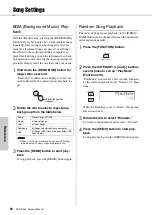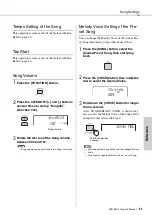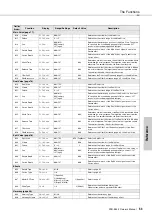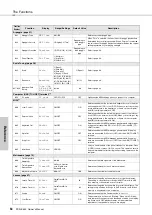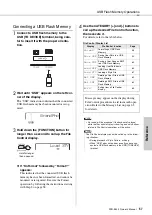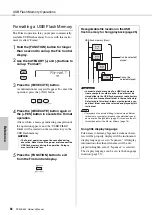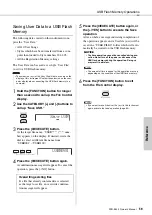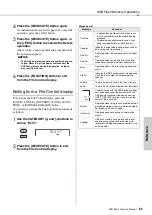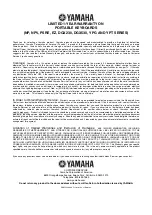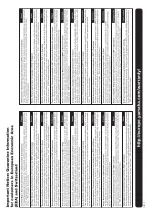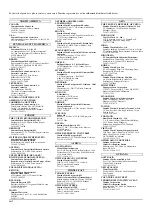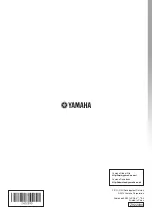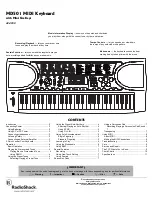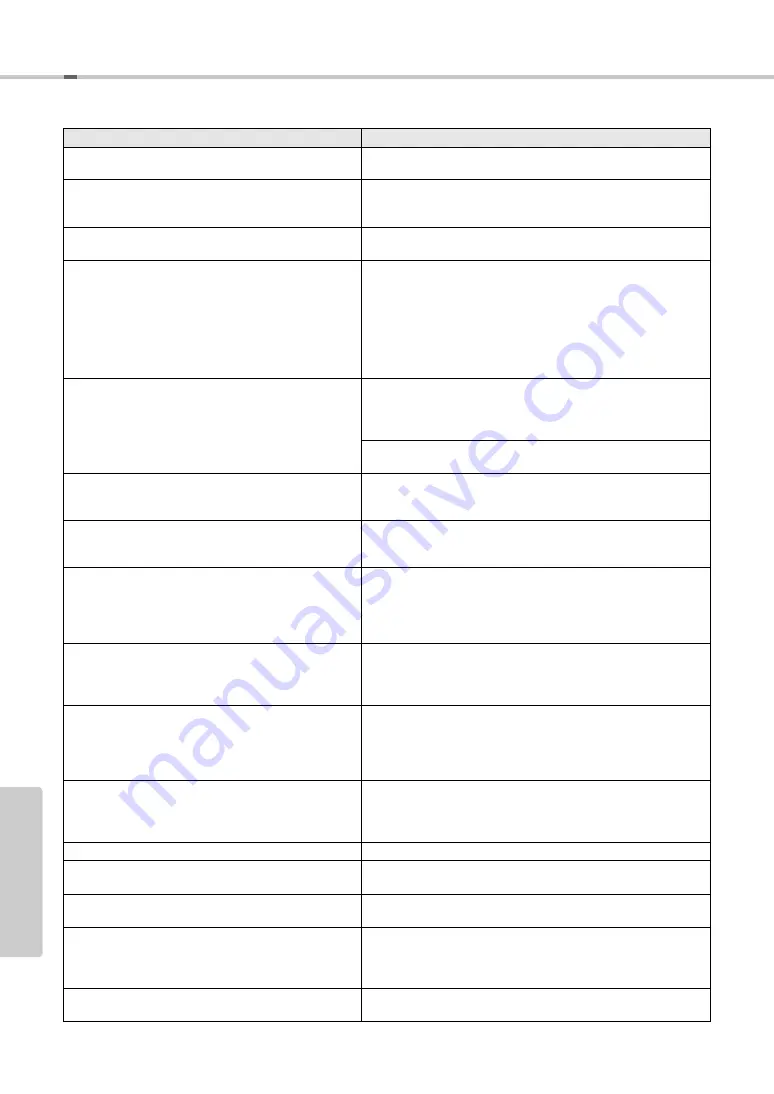
PSR-E443 Owner’s Manual
64
Appendix
Troubleshooting
Problem
Possible Cause and Solution
When the instrument is turned on or off, a popping
sound is temporarily produced.
This is normal and indicates that the instrument is receiving electri-
cal power.
When using a mobile phone, noise is produced
Using a mobile phone in close proximity to the instrument may pro-
duce interference. To prevent this, turn off the mobile phone or use
it further away from the instrument
The instrument is automatically turned off even if no
operation is done.
This is normal. This occurs due to the Auto Power Off function
(page 15).
The volume is too soft.
The sound quality is poor.
The Style/Pattern/Song/Arpeggio stops unexpectedly or
will not play.
The recorded data of the song, etc. does not play cor-
rectly.
The LCD display suddenly goes dark, and all panel set-
tings are reset.
The batteries are low or dead. Replace all six batteries with com-
pletely new ones or completely recharged ones, or use the AC
power adaptor.
No sound is produced even when the keyboard is
played, or a Song, Style, or Pattern is being played back.
Check whether a set of headphones or an audio cable is con-
nected to the [PHONES/OUTPUT], or not. When such a connec-
tion is made, no sound is output from the speaker of this
instrument.
Check the on/off status of the Local Control (page 54). Normally,
set this parameter to ON.
The footswitch (for sustain) seems to produce the oppo-
site effect. For example, pressing the footswitch cuts off
the sound and releasing it sustains the sounds.
The polarity of the footswitch is reversed. Make sure that the foot-
switch plug is properly connected to the SUSTAIN jack before turn-
ing on the power.
No sound is produced even when playing keys in the
right hand area of the keyboard, although chords played
in the left hand area are recognized.
Check whether or not the Dictionary function (page 49) is used.
When used, this is normal.
Not all of the Voices seem to sound, or the sound seems
to be cut off, when playing the keyboard, Arpeggio, Style
or Pattern or Song.
You have exceeded 32 simultaneous notes, which is the maximum
polyphony (the maximum amount of notes that can be played
simultaneously) of this instrument. If the Main, Dual, and Split
Voices are being used along with playback of Arpeggio, Style, Pat-
tern or Song, some notes/sounds may be omitted (or “stolen”).
The sound of the Voice changes from note to note.
This is normal. The tone generation method uses multiple record-
ings (samples) of an instrument across the range of the keyboard;
thus, the actual sound of the Voice may be slightly different from
note to note.
The keyboard performance and playback of Style/Pat-
tern/Song produces an unexpected or inappropriate
sound, and cannot be restored to the normal status.
Using the Knobs can produce dramatic changes in the sound, but
may also produce unexpected or undesired sounds. If you want to
restore the original, normal sound before being changed by the
Knobs, change the Voice, Style, Pattern or Song, or press the
[PORTABLE GRAND] button to reset the panel settings.
The Style, Pattern or Song does not start even when the
[START/STOP] button is pressed. The Arpeggio does
not start even when the note is pressed with the Arpeg-
gio turned on.
Check the on/off status of the External Clock (page 54). Normally,
set this parameter to OFF.
The volume of the Style, Pattern or Song is too low.
Check the volume setting in the Functions (pages 47 and 51).
The chords played in the left hand area cannot be recog-
nized even when the ACMP is turned on.
Check the Split Point setting (page 47). Set this to the appropriate
value.
Style parts other than the Rhythm part produce no
sound.
Check the on/off status of the ACMP (page 23). Make sure to turn
ACMP on.
The Styles numbered 176 or 188–200 produce no
rhythm drum sound even when the [START/STOP] but-
ton is pressed.
This is normal. Style numbers 176 and 188–200 have no rhythm
parts, so no rhythm will play. When one of these Styles is selected,
turn ACMP on, then specify the chord in the left hand area to play
Style parts other than the Rhythm part.
The ACMP indicator does not appear on the display
when the [ACMP ON/OFF] button is pressed.
Check the on/off status of the [STYLE] lamp. When using a Style,
press the [STYLE] button to turn on the [STYLE] lamp.
Appendix
Summary of Contents for PSR-E443
Page 1: ...DIGITAL KEYBOARD Setting Up Reference Appendix Quick Guide Owner s Manual EN ...
Page 68: ...MEMO ...
Page 70: ......

